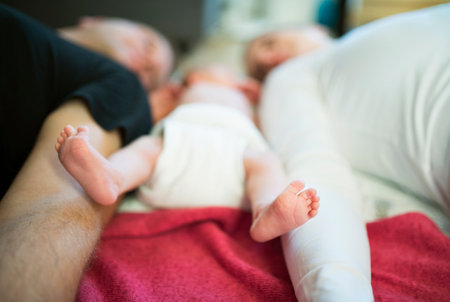Understanding Diaper Rash
Diaper rash is a common skin irritation that affects many babies at some point during their diaper-wearing years. As a parent or caregiver, it’s important to recognize what diaper rash looks like and what causes it so you can address it quickly and keep your little one comfortable. Typically, diaper rash appears as red, inflamed patches on your baby’s bottom, thighs, or genital area. Sometimes the skin may look puffy or feel warm to the touch, and in more severe cases, you might notice blisters or open sores.
The most common cause of diaper rash is prolonged exposure to moisture—especially urine and stool—which can break down your baby’s sensitive skin. Other factors like chafing from tight diapers, reactions to new foods, antibiotics, or even a change in laundry detergent can also trigger rashes. By understanding what diaper rash is and knowing its signs—such as redness, swelling, or fussiness during diaper changes—you’ll be better prepared to prevent it and respond quickly if it happens.
2. Everyday Prevention Strategies
Keeping your baby comfortable starts with daily routines that help prevent diaper rash before it begins. Adopting consistent habits and making smart choices about products can make a big difference in your babys skin health. Here are some practical tips you can easily incorporate into your day:
Frequent Diaper Changes
The number one rule is to change diapers as soon as theyre wet or soiled. Allowing moisture to sit against your babys skin for too long is the leading cause of irritation and rash. Most pediatricians recommend checking your baby’s diaper every two to three hours, and always after feedings or naps.
Choosing the Right Products
Not all diapers and wipes are created equal. Fragrance-free and hypoallergenic options are less likely to irritate sensitive skin. It can take some trial and error to find what works best for your baby, but here’s a quick comparison to guide your choices:
| Product Type | What to Look For | Avoid |
|---|---|---|
| Diapers | Super absorbent, breathable material, proper fit | Fragrances, dyes, tight elastic bands |
| Wipes | Alcohol-free, fragrance-free, gentle formula | Alcohol, harsh chemicals, strong scents |
| Creams/Ointments | Zinc oxide or petroleum-based barriers | Perfumes, unnecessary additives |
Other Healthy Habits
- Let Skin Breathe: Give your baby some diaper-free time each day—fresh air helps keep skin dry and healthy.
- Gentle Cleaning: Use lukewarm water and a soft cloth or cotton balls during changes instead of wipes if your baby’s skin is sensitive.
- Pat Dry, Don’t Rub: After cleaning, gently pat the area dry rather than rubbing. Moisture trapped in skin folds can lead to rashes.
- Avoid Over-tightening: Make sure diapers fit snugly but aren’t too tight; this prevents chafing and allows airflow.
The Bottom Line: Consistency Matters
The best way to prevent diaper rash is by staying proactive with these daily habits. With patience and attention, you’ll create a routine that keeps your little one comfortable—and those precious giggles coming.

3. Choosing the Right Diapers and Wipes
When it comes to preventing and treating diaper rash, the type of diapers and wipes you choose can make a world of difference for your babys comfort. Not all diapers are created equal—some materials are gentler on sensitive skin, while others may trap moisture or cause irritation. Many American parents find that fragrance-free and hypoallergenic options help reduce the risk of rashes, especially for babies with delicate skin. Cloth diapers, while eco-friendly, require frequent changes and careful laundering to avoid detergent buildup that could irritate your babys bottom. On the other hand, disposable diapers often have super-absorbent layers that pull moisture away from the skin, but it’s important to select brands free from harsh chemicals or dyes.
Wipes are another key factor in maintaining healthy skin. Look for alcohol-free and unscented baby wipes, as these are less likely to cause stinging or dryness. Some parents even opt for plain water and soft washcloths during flare-ups or if their child is particularly sensitive. When shopping, check labels for terms like “dermatologist-tested,” “hypoallergenic,” and “free from parabens and phthalates.” Remember, what works well for one baby might not be perfect for another—it can take some trial and error to find products that keep your little one happy and rash-free.
4. Gentle Cleaning and Care Routines
Caring for your babys delicate skin during diaper changes is one of the most important steps you can take to prevent and treat diaper rash. Gentle cleaning routines not only help remove irritants but also keep your baby comfortable. Here’s how you can safely clean your baby’s bottom and keep their skin healthy with each change.
Safe Cleaning Techniques
Always use lukewarm water and a soft, clean washcloth or cotton pads to gently wipe your baby’s bottom. Avoid scrubbing or rubbing too hard, as this can further irritate sensitive skin. If you prefer wipes, choose fragrance-free and alcohol-free varieties designed specifically for babies. After cleaning, pat the area dry instead of rubbing to minimize irritation.
Recommended Cleaning Methods
| Cleaning Method | When to Use | Tips |
|---|---|---|
| Warm Water & Washcloth | Every diaper change, especially with sensitive skin or rash present | Pat dry gently; air-dry if possible |
| Baby Wipes (Fragrance-Free) | On-the-go or when water isn’t available | Avoid wipes with alcohol or harsh chemicals |
| Cotton Balls/Pads | For newborns or severe rashes | Saturate in warm water for extra gentleness |
Keeping Skin Dry and Healthy
After every cleaning, make sure your baby’s bottom is completely dry before putting on a fresh diaper. Moisture is one of the main culprits behind diaper rash. Allowing your baby some “diaper-free” time each day helps their skin breathe and recover. If you’re using creams or ointments, apply a thin layer of a barrier cream containing zinc oxide or petroleum jelly to protect the skin from moisture and friction.
Helpful Tips for Every Change:
- Change diapers frequently—don’t wait until they feel heavy.
- Avoid talcum powder; it can irritate your baby’s lungs and doesn’t help keep skin dry.
- If your baby has frequent rashes, consider trying a different brand of diapers or wipes.
- Dress your baby in loose-fitting, breathable clothing whenever possible.
By following these gentle cleaning and care routines, you can help soothe existing diaper rash and prevent future flare-ups, keeping your little one comfortable and happy through every stage of infancy.
5. Treating Diaper Rash at Home
When diaper rash strikes, taking action at home can make a big difference in your baby’s comfort and recovery. Here’s a step-by-step guide to soothing sore skin and helping your little one feel better fast.
Step 1: Keep It Clean and Dry
Gently clean your baby’s diaper area with warm water and a soft washcloth or fragrance-free wipes. Pat the skin dry—don’t rub, as this can irritate already sensitive areas. Make sure the area is completely dry before putting on a fresh diaper.
Step 2: Use Barrier Creams
Apply a thick layer of barrier cream or ointment that contains zinc oxide or petroleum jelly. These products protect the skin from further moisture and help it heal. Don’t be afraid to apply generously; the goal is to create a protective shield between your baby’s skin and wetness.
Step 3: Let Skin Breathe
Whenever possible, let your baby go diaper-free for short periods throughout the day. Place them on a towel or waterproof mat and let their skin air out. This simple step can speed up healing by reducing constant exposure to moisture.
Step 4: Choose Diapers Wisely
If you’re not already using super-absorbent disposable diapers, consider making the switch while your baby heals. Change diapers frequently, even if they’re only slightly wet. For some babies, cloth diapers can be gentler—but remember to use fragrance-free detergent and rinse thoroughly.
Step 5: Avoid Irritants
Skip powders, perfumed wipes, or lotions that might sting or aggravate your baby’s rash. Stick with mild, unscented cleansers and always do a patch test if you try something new.
When to Call Your Pediatrician
If the rash doesn’t start improving after a few days of home care, looks severe, or is accompanied by fever or blisters, reach out to your pediatrician right away. Most rashes clear up quickly with attentive care, but sometimes prescription creams or further guidance are needed for tougher cases.
6. When to Call Your Pediatrician
As parents, it’s natural to worry when your baby seems uncomfortable, but most diaper rashes clear up with home care and a little extra TLC. However, sometimes a diaper rash can signal something more serious that needs professional attention. Knowing when to reach out to your pediatrician is key to keeping your little one healthy and comfortable.
Warning Signs to Watch For
If your baby’s diaper rash doesn’t improve after a few days of at-home treatment, or if it seems to be getting worse, it’s time to consider calling the doctor. Here are some warning signs that mean you should reach out:
- The rash is severe, with blistering, open sores, or oozing yellowish fluid
- Your baby seems especially irritable or in pain during diaper changes
- You notice signs of infection, such as fever, pus, or spreading redness beyond the diaper area
- The rash includes pimples, bumps, or a bright red border (which could indicate a yeast infection)
- The rash isn’t improving after 2-3 days of using over-the-counter creams and frequent diaper changes
Trust Your Parental Instincts
No one knows your baby better than you do. If something feels off or your gut tells you the rash looks unusual, don’t hesitate to call your pediatrician for guidance. It’s always better to err on the side of caution.
How Your Pediatrician Can Help
Your doctor may recommend a stronger prescription cream or check for underlying conditions like bacterial or yeast infections. Sometimes, what looks like diaper rash could actually be eczema or another skin issue that needs specialized care.
Remember: seeking help when you’re unsure isn’t just smart—it’s an important part of keeping your baby happy, healthy, and comfortable.


